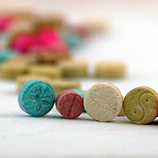East and Southeast Asia, World’s Largest Markets for Synthetic Drugs — Major Drag on Development
20 August 2014 – East and Southeast Asia remain the world’s largest markets for synthetic drugs, and the methamphetamine problem is showing signs of accelerating, according to senior policy, law enforcement and justice delegates at a special regional conference organized by UN Office on Drugs and Crime (UNODC) Global SMART Programme which started today in Yangon, Myanmar.
Growing demand in East and Southeast Asia for methamphetamine is being met by large-scale production in China, Myanmar and several other countries in the region. Information presented at the conference confirms continued high, and rising, demand and supply of methamphetamine.
“Organized crime groups are well positioned to take advantage of regional integration agreements to expand the trafficking of synthetic drugs and precursor chemicals” said Jeremy Douglas, UNODC Regional Representative for Southeast Asia and the Pacific.
“Capacities to ensure the rule of law vary greatly across the region, and this evolving and growing threat diverts increasing amounts of scarce state resources away from efforts to develop and improve governance. It can’t be ignored that the billions generated for organized crime exceed the size of several national economies in the region. Where is the money going?” added Douglas.
Transnational Criminal Groups
While most of the methamphetamine produced in East and Southeast Asia is consumed within the region, large quantities are also being trafficked to nearby major markets such as Japan, Australia and New Zealand, and more recently to neighbouring South Asia.
Transnational criminal groups also continue to identify new precursor sources and methods for production, and are diversifying trafficking routes.
Myanmar remains a major source of both methamphetamine pills and crystal methamphetamine, or “ice”, with significant volumes from the country being seized in neighbouring states. At the same time officials from the Government of Myanmar acknowledged that methamphetamine use is rapidly increasing across the country.
“A much greater degree of information sharing and cooperation is needed to effectively respond to the synthetic drug and precursor problems in our country and across ASEAN” said Pol. Brig. Gen. Kyaw Win of the Central Committee for Drug Abuse Control (CCDAC), Ministry of Home Affairs. “No country can tackle these challenges alone, and there is no doubt we need improved training and support for frontline law enforcement and justice officers, especially along the Mekong corridor and in remote areas of the region.”
Several delegations raised concerns about new psychoactive substances (NPS), also known as “legal highs”, being produced by introducing slight modifications to the chemistry of controlled drugs. The fast-paced nature and evolution of the regional drug market has raised concerns that transnational organized criminal groups are expanding product lines to target young people.
Background – the Global SMART Programme
UNODC launched the Global SMART Programme in 2008 to enhance the capacity of states and authorities in East and Southeast Asia to generate, manage, analyse, report and use synthetic drug and precursor information, and to apply this evidence-based knowledge to strategy, policy and programme design and implementation.
Eleven countries in the region receive related assistance from UNODC through Global SMART – Brunei Darussalam, Cambodia, China, Indonesia, the Lao People’s Democratic Republic, Malaysia, Myanmar, the Philippines, Singapore, Thailand and Viet Nam.
The Global SMART Programme receives financial support from the Governments of Australia, Canada, Japan, New Zealand, the Republic of Korea, Russian Federation, Thailand, the United Kingdom and the United States.
Related information: UNODC Regional Office for Southeast Asia and the Pacific
*Source: UNODC










